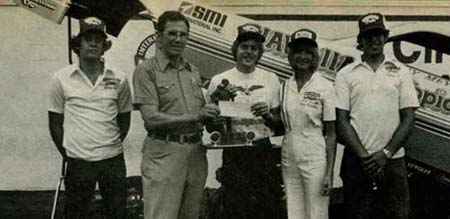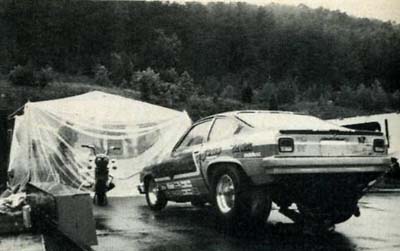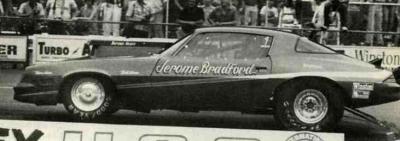BRISTOL WAS THE PLACE TO GET PAID BACK IN THE DAY
Fri, 2010-06-18 17:00
If you were a professional drag racer in 1980, you had one key reason for traveling to race in Bristol, Tenn., you came to get paid. Thunder Valley Dragway, now re-branded as Bristol Dragway, paid like no other race track.
The IHRA Spring Nationals event rewarded its winners with the largest paydays of any national event in drag racing at the time.
An event win in either nitro category paid $20,000; while Pro Stock pocketed a then incredible $10,000.
What was the inspiration for a promoter to offer up such a monetary gold mine?
 If you were a professional drag racer in 1980, you had one key reason for traveling to race in Bristol, Tenn., you came to get paid. Thunder Valley Dragway, now re-branded as Bristol Dragway, paid like no other race track.
If you were a professional drag racer in 1980, you had one key reason for traveling to race in Bristol, Tenn., you came to get paid. Thunder Valley Dragway, now re-branded as Bristol Dragway, paid like no other race track.
The IHRA Spring Nationals event rewarded its winners with the largest paydays of any national event in drag racing at the time.
An event win in either nitro category paid $20,000; while Pro Stock pocketed a then incredible $10,000.
What was the inspiration for a promoter to offer up such a monetary gold mine?If you were a professional drag racer in 1980, you had one key reason for traveling to race in Bristol, Tenn., you came to get paid. Thunder Valley Dragway, now re-branded as Bristol Dragway, paid like no other race track.
The IHRA Spring Nationals event rewarded its winners with the largest paydays of any national event in drag racing at the time.
An event win in either nitro category paid $20,000; while Pro Stock pocketed a then incredible $10,000.
What was the inspiration for a promoter to offer up such a monetary gold mine?
For Larry Carrier, then IHRA President and owner of Thunder Valley Dragway, the largest payday meant the most efficient way to ensure his flagship event would draw the same discussions as the NHRA’s U.S. Nationals. Carrier decided he would gain more attention by ceasing to pay drag racing’s superstars appearance money and instead put it into a pot and let whomever showed up battle for a big payday.
 A year earlier, 1979, Carrier's Spring Nationals event had already become a conversation piece but for the wrong reasons. Rain forced a one-week delay, and then a subsequent downpour on the rescheduled final eliminations day pushed the starting time until 7 PM on Sunday. Carrier gave his “come hell or high water” (he had both) speech, and at 2 AM on Monday morning the final two cars went down the track, bringing to a close the event which was sponsored, ironically, by local soft drink company Sun Drop.
A year earlier, 1979, Carrier's Spring Nationals event had already become a conversation piece but for the wrong reasons. Rain forced a one-week delay, and then a subsequent downpour on the rescheduled final eliminations day pushed the starting time until 7 PM on Sunday. Carrier gave his “come hell or high water” (he had both) speech, and at 2 AM on Monday morning the final two cars went down the track, bringing to a close the event which was sponsored, ironically, by local soft drink company Sun Drop.
In those early days, bringing in big names was how Carrier did business. He never scripted the outcome of the races, he just wanted their presence for advertising purposes.
No two racers received the same incentive money. One driver might be guaranteed a minimum amount, the equivalent of third round money, for example, or if the posted purse was $500, a “name” racer might take home $800. That was enough bait to lure them to Bristol.
Ted Jones had a front row seat to it all, serving as Carrier’s second-in-command for many years.
“It worked,” Jones said. “He had the names to put on his advertising and that attracted the fans. It worked very well, and for that reason the IHRA was an almost instant success. The big names were always determined by what they did in NHRA competition. If you did well over there – you were considered a big name.”
Carrier’s $20,000 purse for each of the nitro-burning divisions would equal a payday of nearly $200,000 to win in today’s world. Thirty years later, his purse is half of the current winning purse of the NHRA Thunder Valley Nationals.
To avoid the rain issues, Carrier studied the almanac and moved the event ahead by a month.
Carrier even added to the experience for fans and spectators by installing a new ahead-of-its time scoreboard system. For the first time in drag racing history, the elapsed times and sportsman dial-ins were displayed for all to see at the finish line.
Dave Bishop was one of the leading freelancers of the era, covering the event for the IHRA’s Drag Review paper and leading monthly magazine Super Stock and Drag Illustrated.
“The thing you took notice of immediately were the large fields of cars,” Bishop said. “That was one of two things you expected from that event. There were lots of cars and plenty of rain every year.
 “When Carrier announced what he was going to pay, it was a tremendous amount of money. It was extra huge. It was evident that he intended to have the best field of drag racing that one could have. The IHRA was always the underdog and they always tried to be one up on the NHRA. That was what precipitated this whole thing.
“When Carrier announced what he was going to pay, it was a tremendous amount of money. It was extra huge. It was evident that he intended to have the best field of drag racing that one could have. The IHRA was always the underdog and they always tried to be one up on the NHRA. That was what precipitated this whole thing.
“The place was packed. You could see people on the hills and it didn’t matter if it did rain – they were going to be there. They wanted to see a quality show and they got that.”
The fans got a quality show and the drag racers a quality payoff all because Carrier realized for an event to be big everyone in attendance, fans and competitors, had to believe it was a big event. Which, in the case of the IHRA Spring Nationals was without question.
The IHRA Spring Nationals event rewarded its winners with the largest paydays of any national event in drag racing at the time.
An event win in either nitro category paid $20,000; while Pro Stock pocketed a then incredible $10,000.
What was the inspiration for a promoter to offer up such a monetary gold mine?

Larry Carrier presents Billy Meyer with the substantial $20,000 check for winning the Pro Funny title at the IHRA Spring Nationals.
The IHRA Spring Nationals event rewarded its winners with the largest paydays of any national event in drag racing at the time.
An event win in either nitro category paid $20,000; while Pro Stock pocketed a then incredible $10,000.
What was the inspiration for a promoter to offer up such a monetary gold mine?If you were a professional drag racer in 1980, you had one key reason for traveling to race in Bristol, Tenn., you came to get paid. Thunder Valley Dragway, now re-branded as Bristol Dragway, paid like no other race track.
The IHRA Spring Nationals event rewarded its winners with the largest paydays of any national event in drag racing at the time.
An event win in either nitro category paid $20,000; while Pro Stock pocketed a then incredible $10,000.
What was the inspiration for a promoter to offer up such a monetary gold mine?
For Larry Carrier, then IHRA President and owner of Thunder Valley Dragway, the largest payday meant the most efficient way to ensure his flagship event would draw the same discussions as the NHRA’s U.S. Nationals. Carrier decided he would gain more attention by ceasing to pay drag racing’s superstars appearance money and instead put it into a pot and let whomever showed up battle for a big payday.

The 1979 IHRA Spring Nationals was a promotional disaster with rain and lots of it. The next year's big payoff more than made up for it.
In those early days, bringing in big names was how Carrier did business. He never scripted the outcome of the races, he just wanted their presence for advertising purposes.
No two racers received the same incentive money. One driver might be guaranteed a minimum amount, the equivalent of third round money, for example, or if the posted purse was $500, a “name” racer might take home $800. That was enough bait to lure them to Bristol.
Ted Jones had a front row seat to it all, serving as Carrier’s second-in-command for many years.
“It worked,” Jones said. “He had the names to put on his advertising and that attracted the fans. It worked very well, and for that reason the IHRA was an almost instant success. The big names were always determined by what they did in NHRA competition. If you did well over there – you were considered a big name.”
Carrier’s $20,000 purse for each of the nitro-burning divisions would equal a payday of nearly $200,000 to win in today’s world. Thirty years later, his purse is half of the current winning purse of the NHRA Thunder Valley Nationals.
To avoid the rain issues, Carrier studied the almanac and moved the event ahead by a month.
Carrier even added to the experience for fans and spectators by installing a new ahead-of-its time scoreboard system. For the first time in drag racing history, the elapsed times and sportsman dial-ins were displayed for all to see at the finish line.
Dave Bishop was one of the leading freelancers of the era, covering the event for the IHRA’s Drag Review paper and leading monthly magazine Super Stock and Drag Illustrated.
“The thing you took notice of immediately were the large fields of cars,” Bishop said. “That was one of two things you expected from that event. There were lots of cars and plenty of rain every year.

Warren Johnson is the only professional racer competing this weekend who took home one of Carrier's large checks. He won $10,000 for capturing the Pro Stock title.
“The place was packed. You could see people on the hills and it didn’t matter if it did rain – they were going to be there. They wanted to see a quality show and they got that.”
The fans got a quality show and the drag racers a quality payoff all because Carrier realized for an event to be big everyone in attendance, fans and competitors, had to believe it was a big event. Which, in the case of the IHRA Spring Nationals was without question.
Categories:





































